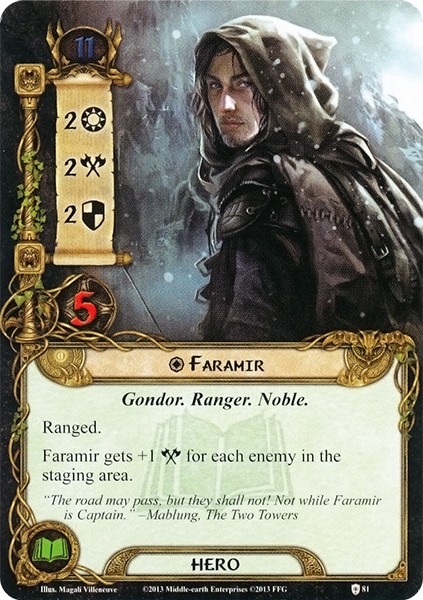Faramir is one of my favorite heroes in the game despite some generally poor reviews from the community. The heroes that take some deckbuilding and finesse to bring out their potential are so much more fun to play than the overpowered "do everything" heroes that fit into any deck type, and Faramir is no exception. Tactics "Boring"mere may be great for new players, but should be a big yawn for those of us who like some variety and spice in our LOTR:LCG.
The first thing to know about Faramir is that he exists for pretty much one deck archetype, the "Ithilien Ranger Trap" deck. His stats are balanced, making him a great target for action advantage cards such as "Wingfoot", and they correctly match his starting threat. The downside of Faramir is that his ability really isn't that great in general use decks. However, the upside is that it Is boss in the "Ithilien Ranger" deck, which specializes in locking enemies into the staging area and dealing with them there. He combos great with Ithilien traps, which lock enemies into the staging area and thus provide a "permanent" attack boost for Farimir, and Ithilien pits, which make enemies in staging open to normal attacks from anybody (including the guy who gets boosted from them). Once you get Faramir set up, he can crush with the best of them. With a properly built "Ithilien Ranger" deck, it is no problem to have 4 enemies in staging in most games, which gives Faramir a 6 attack unmodified. I've had him attacking for as high as 10+ when modified!
The biggest criticism I've seen of Faramir so far, is that he has to compete with another qualified candidate for his own niche... Haldir of Lorien. At first glance, Haldir might seem like he is the better Ithilien trap hero with a base attack of 3, lower threat (making it easier to keep enemies in staging), and the ability to target enemies in staging. However, I've found that when I create Ithilien trap decks, I'm tending to use low threat characters like Hobbits or Mirlonde that are squishy on hitpoints. For my money, Faramir's 2 extra threat is a constraint that I can work around for the 2 extra hitpoints and extra point of defense that is crucial in covering up one of the glaring weaknesses of Ithilien Trap decks, which is those pesky low engagement enemies that get past traps and engage. Bottom line, Faramir can take a punch where Haldir can't, and that's value. He can defend "slip through" attacks early on, and can also soak up more direct damage and take most undefended attacks in a pinch.... and don't forget that he inhabits the one sphere in the game with healing!
Haldir does have a bit of an advantage being able to attack staging, but Ithilien pits do the same thing... and though they may be less consistent, they also have the advantage of "trapping" an enemy, which also trigger ancillary benefits that are built in to a good trap deck. If you are worried about good targetting, keep some Ithilien archers or ally Mablung around to "engage and bounce" the enemy of choice back into your pit. Plus, even though Haldir might come out of the gates with a higher attack, how many times have you seen Haldir swing for 10?
Faramir may not be the first hero I'd recommend to a brand new player, but if you are looking for a hero who has some great potential that requires a bit of finesse to unlock, give him a try! He is a lot of fun.
